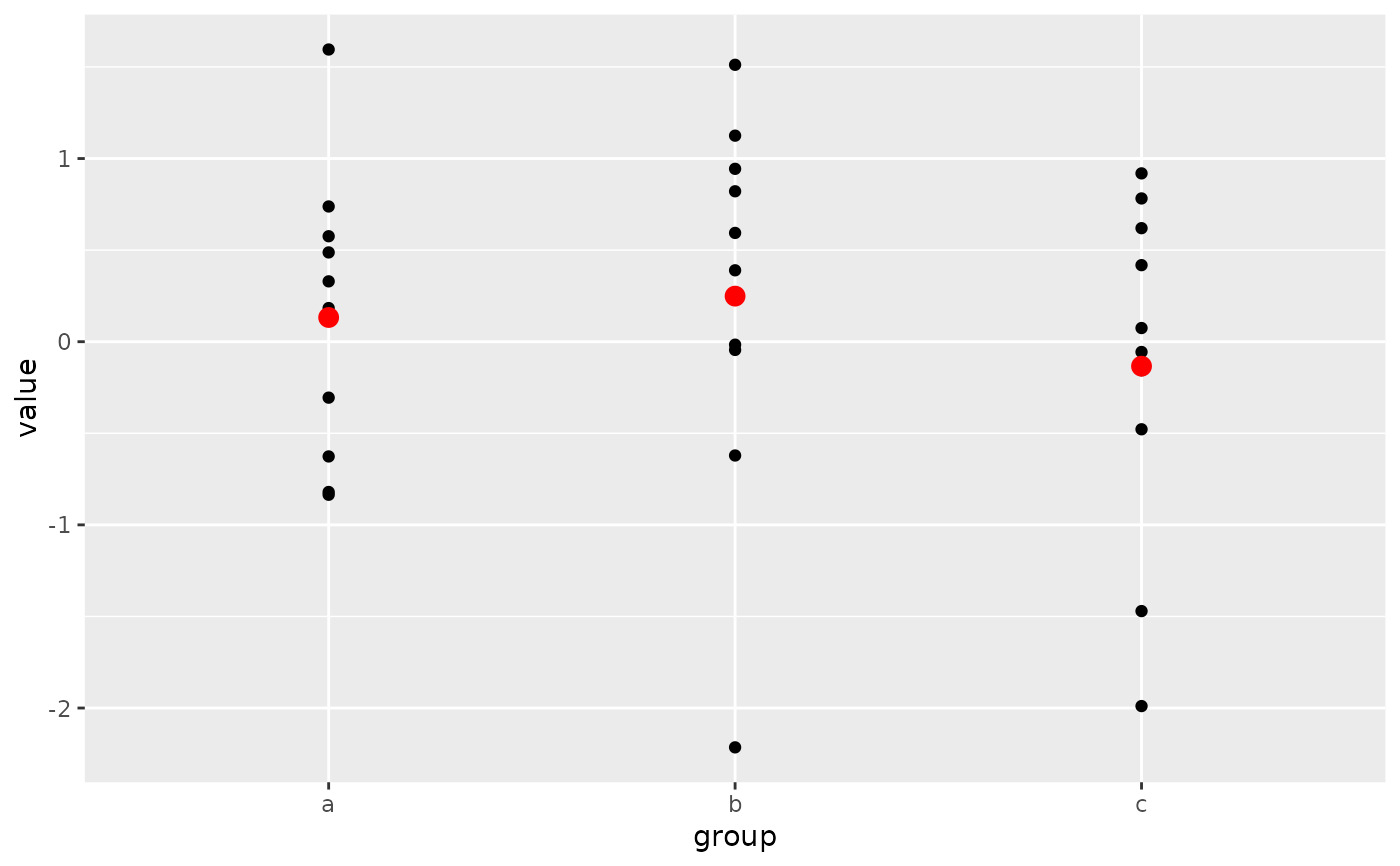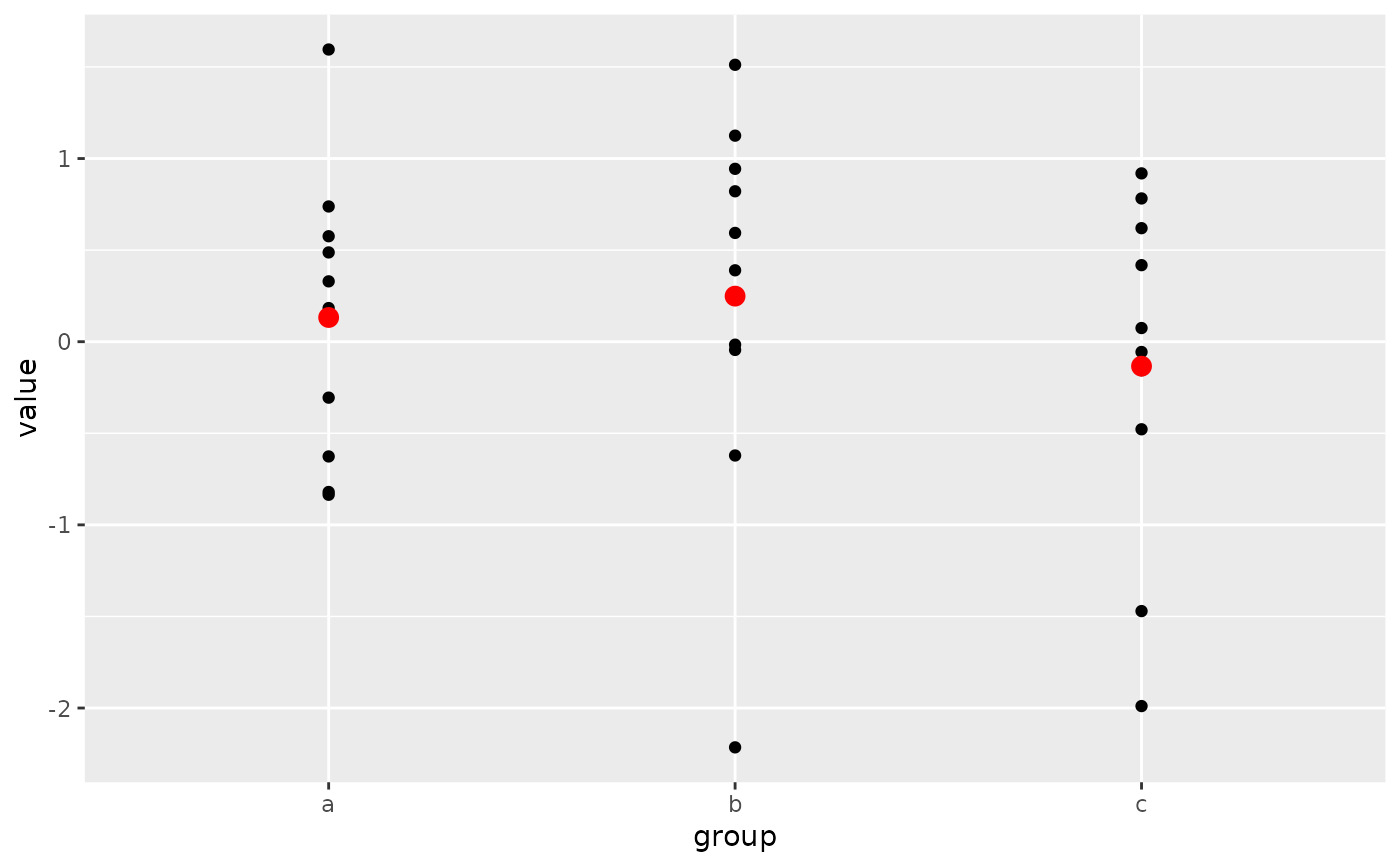ggplot() 初始化 ggplot 對象。它可用於聲明圖形的輸入數據幀,並指定一組在所有後續層中通用的繪圖美學,除非特別覆蓋。
參數
- data
-
用於繪圖的默認數據集。如果還不是 data.frame,將由
fortify()轉換為 data.frame。如果未指定,則必須在添加到繪圖的每個圖層中提供。 - mapping
-
用於繪圖的默認美學映射列表。如果未指定,則必須在添加到繪圖的每個圖層中提供。
- ...
-
其他參數傳遞給方法。目前未使用。
- environment
-
在整潔評估之前使用。
細節
ggplot() 用於構造初始繪圖對象,並且後麵幾乎總是跟有一個加號 ( + ) 以將組件添加到繪圖中。
用於調用 ggplot() 的三種常見模式:
-
ggplot(data = df, mapping = aes(x, y, other aesthetics)) -
ggplot(data = df) -
ggplot()
如果所有圖層都使用相同的數據和相同的美學集,則建議使用第一種模式,盡管在使用來自另一個數據幀的數據添加圖層時也可以使用此方法。
第二個模式指定用於繪圖的默認 DataFrame ,但沒有預先定義美觀。當一個 DataFrame 主要用於繪圖但美觀程度因圖層而異時,這非常有用。
第三種模式初始化一個骨架 ggplot 對象,該對象隨著層的添加而充實。當使用多個數據幀生成不同的圖層時(複雜圖形中經常出現這種情況),這非常有用。
參數中的 data = 和 mapping = 規範是可選的(在實踐中經常被省略),隻要數據和映射值以正確的順序傳遞到函數中即可。然而,在下麵的示例中,為了清楚起見,它們保留在原處。
例子
# Create a data frame with some sample data, then create a data frame
# containing the mean value for each group in the sample data.
set.seed(1)
sample_df <- data.frame(
group = factor(rep(letters[1:3], each = 10)),
value = rnorm(30)
)
group_means_df <- setNames(
aggregate(value ~ group, sample_df, mean),
c("group", "group_mean")
)
# The following three code blocks create the same graphic, each using one
# of the three patterns specified above. In each graphic, the sample data
# are plotted in the first layer and the group means data frame is used to
# plot larger red points on top of the sample data in the second layer.
# Pattern 1
# Both the `data` and `mapping` arguments are passed into the `ggplot()`
# call. Those arguments are omitted in the first `geom_point()` layer
# because they get passed along from the `ggplot()` call. Note that the
# second `geom_point()` layer re-uses the `x = group` aesthetic through
# that mechanism but overrides the y-position aesthetic.
ggplot(data = sample_df, mapping = aes(x = group, y = value)) +
geom_point() +
geom_point(
mapping = aes(y = group_mean), data = group_means_df,
colour = 'red', size = 3
)
 # Pattern 2
# Same plot as above, passing only the `data` argument into the `ggplot()`
# call. The `mapping` arguments are now required in each `geom_point()`
# layer because there is no `mapping` argument passed along from the
# `ggplot()` call.
ggplot(data = sample_df) +
geom_point(mapping = aes(x = group, y = value)) +
geom_point(
mapping = aes(x = group, y = group_mean), data = group_means_df,
colour = 'red', size = 3
)
# Pattern 2
# Same plot as above, passing only the `data` argument into the `ggplot()`
# call. The `mapping` arguments are now required in each `geom_point()`
# layer because there is no `mapping` argument passed along from the
# `ggplot()` call.
ggplot(data = sample_df) +
geom_point(mapping = aes(x = group, y = value)) +
geom_point(
mapping = aes(x = group, y = group_mean), data = group_means_df,
colour = 'red', size = 3
)
 # Pattern 3
# Same plot as above, passing neither the `data` or `mapping` arguments
# into the `ggplot()` call. Both those arguments are now required in
# each `geom_point()` layer. This pattern can be particularly useful when
# creating more complex graphics with many layers using data from multiple
# data frames.
ggplot() +
geom_point(mapping = aes(x = group, y = value), data = sample_df) +
geom_point(
mapping = aes(x = group, y = group_mean), data = group_means_df,
colour = 'red', size = 3
)
# Pattern 3
# Same plot as above, passing neither the `data` or `mapping` arguments
# into the `ggplot()` call. Both those arguments are now required in
# each `geom_point()` layer. This pattern can be particularly useful when
# creating more complex graphics with many layers using data from multiple
# data frames.
ggplot() +
geom_point(mapping = aes(x = group, y = value), data = sample_df) +
geom_point(
mapping = aes(x = group, y = group_mean), data = group_means_df,
colour = 'red', size = 3
)

相關用法
- R ggplot2 ggproto 創建一個新的 ggproto 對象
- R ggplot2 ggsf 可視化 sf 對象
- R ggplot2 ggsave 使用合理的默認值保存 ggplot (或其他網格對象)
- R ggplot2 ggtheme 完整的主題
- R ggplot2 gg-add 將組件添加到圖中
- R ggplot2 geom_qq 分位數-分位數圖
- R ggplot2 geom_spoke 由位置、方向和距離參數化的線段
- R ggplot2 geom_quantile 分位數回歸
- R ggplot2 geom_text 文本
- R ggplot2 get_alt_text 從繪圖中提取替代文本
- R ggplot2 geom_ribbon 函數區和麵積圖
- R ggplot2 geom_boxplot 盒須圖(Tukey 風格)
- R ggplot2 geom_hex 二維箱計數的六邊形熱圖
- R ggplot2 geom_bar 條形圖
- R ggplot2 guide_legend 圖例指南
- R ggplot2 geom_bin_2d 二維 bin 計數熱圖
- R ggplot2 geom_jitter 抖動點
- R ggplot2 geom_point 積分
- R ggplot2 geom_linerange 垂直間隔:線、橫線和誤差線
- R ggplot2 geom_blank 什麽也不畫
- R ggplot2 guides 為每個尺度設置指南
- R ggplot2 geom_path 連接觀察結果
- R ggplot2 geom_violin 小提琴情節
- R ggplot2 guide_bins Guide_legend 的分箱版本
- R ggplot2 geom_dotplot 點圖
注:本文由純淨天空篩選整理自Hadley Wickham等大神的英文原創作品 Create a new ggplot。非經特殊聲明,原始代碼版權歸原作者所有,本譯文未經允許或授權,請勿轉載或複製。
